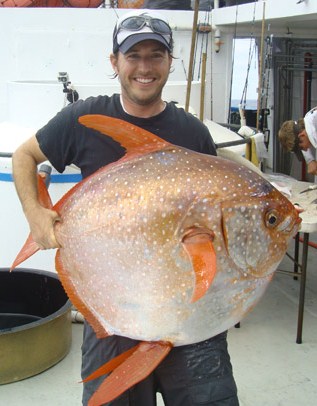The first fully warm-blooded fish has been found by researchers in California.
Think of a fish, but not too big. Now, think of holding that fish. How does it feel? Probably wet, slippery and cold! The majority of fish are cold-blooded, meaning they do not regulate their body temperature. Instead it adjusts with the ambient temperature of the surrounding water.
Nevertheless, some very active fish species, like predatory tuna and salmon sharks, have evolved the ability to direct heat into certain parts of their bodies for short periods of time. This boosts muscle performance, helping them to hunt down prey. But regionally endothermic species like these account for only 0.1% of fish, and most of their bodies still remain at ambient temperature owing to heat loss into the water.
Scientists were surprised, then, to discover recently a fully warm-blooded fish. The opah, or Lampris guttatus, is a large, almost disc shaped fish, with big round sides but next to no width. These fish live all over the world, in Argentina, Norway, California and even Senegal. But because they live out in the ocean, at depths between 50m and 500m they are relatively understudied. You're most likely to see one in Hawaii - in a restaraunt on your plate!
Warm-bloodedness, or endothermy, is generally found only in mammals and birds, making the discovery a surprise. "Unlike other fish, opah distribute warmed blood throughout the body, including to the heart, enhancing physiological performance," explains NOAA Fisheries biologist Nick Wergner, who has published the discovery in the journal Science (Animal Physiology). The first of its type, the fish consistently keeps its body temperature 5º Celsius above that of its deep-water surroundings.
It achieves this by preventing the biggest source of heat loss for most fish, which happens at the gills when warmer blood comes into close contact with cold water. These opah have developed "wonderful nets" of densely-packed blood vessels that use "counter-current" heat exchange to claw back heat that would otherwise be lost. The vessels are arranged in such a way that hot blood from inside the core flows past and heats up cold blood from near the gills. This entire exchange is thermally isolated from the rest of the body by a thick layer of fatty insulation.
The blood is initially heated by the continous flapping of the opah's pecotoral fins, which keeps them swimming. Although these fins look small, the muscles that move them account for 16% of the opah's total body mass - the highest reported ratio for any fish - and moving them generates the heat needed to stay warm.
So why has this trait evolved in this species? It turns out that having a warm core, heart and brain means the opah's internal systems function rapidly and responsively in the deep, cold environment they inhabit.
Warm muscles mean it can generate more muscle power and stay active for longer. It can also remain submerged at greater depth for much longer without having to rise to the surface to warm up, which gives it a hunting advantage over its cold-blooded counterparts. A killer that's warm-hearted, you might say...
- Previous What your microbiome says about you
- Next How Hearing Works










Comments
Add a comment